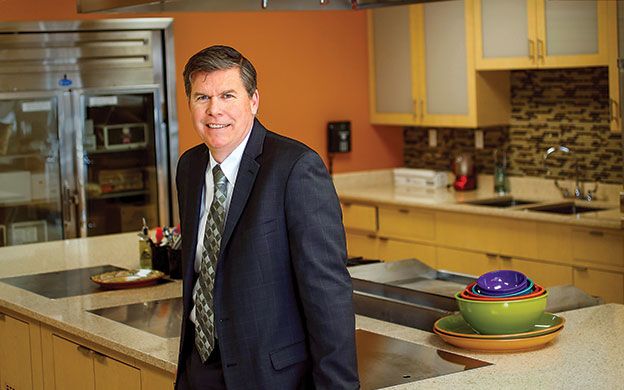MaineGeneral's biggest investment? Workplace wellness
Chuck Hays, president and CEO of MaineGeneral Health Services, the state's third-largest health care system, has no trouble explaining why it's good business for employers to take a proactive role in helping their workers stay healthy.
He's got MaineGeneral's Workplace Health department as an example. Per-employee paid health claims for the system's 4,300 employees have been lower than expected since 2008, with 2014's $8,451 cost actually being lower than 2008's per capita cost. Its most recent workers' compensation MOD rate, a measurement of its workers' comp experience, was 0.47, less than half the 1.0 average rate for hospitals. Employee benefit costs have not risen for three years.
But for any stubborn skeptics who might wonder how paying attention to workplace health might work in a riskier, more challenging industrial setting, Hays says that before there was even a shovel in the ground for MaineGeneral's $312 million hospital that opened two years ago, the medical center tapped Workplace Health to provide medical services at the Augusta construction site for upwards of 700 construction workers.
“It saved us almost $1 million in insurance costs as we were building the hospital itself,” he says, noting that the department installed a medical trailer onsite, where emergency medical technicians could quickly assess all construction-related injuries and complaints and provide immediate first aid — or send workers with more serious injuries to its Augusta office for further assessment and treatment. That proactive approach helped the project's insurance loss ratio come in at 9.8% — far less than the 29% that had been projected for a construction project involving a 640,000-square-foot building.
In addition to the direct impact it's having on the health of hospital employees, Hays says the Workplace Health department is proving to be an “incredible asset to MaineGeneral and our desire to help the people we serve stay healthy and well.” The Affordable Care Act has played a role in that mission, he adds, by expanding coverage for many prevention and wellness services, including incentives for employers to provide wellness programs. The business case for proactively investing in healthy employees, according to the federal Centers for Disease Control and Prevention, is based on the fact that 75% of health care costs is spent on preventable diseases.
“With the shift of health care, in general, dealing more with 'wellness,' Workforce Health has shifted more of its attention to that realm as well,” Hays says. “We think wellness is the direction health care needs to travel — for everyone, not just for workplaces. I will tell you, though, I don't think any of our companies would take our Workplace Health service if they weren't seeing a return on the bottom line themselves.”
Tackling workers' comp
A for-profit center within the MaineGeneral system, Workplace Health currently works with 250 businesses in the Kennebec Valley region that collectively employ roughly 20,000 workers.
Helping employers improve on-the-job safety was the department's primary mission when it was launched more than 20 years ago in response to Maine's 1992 workers' compensation reforms. But that focus has evolved into the broader mission of assisting companies create wellness programs for their employees as an effective way of reducing their overall health care costs.
“I run it like a business,” says Denise Dumont-Bernier, a physical therapist who was recruited to run the department following a long career in occupational health that included stints providing onsite health care at L.L.Bean and Bath Iron Works. The department's profit, she says, helps the parent organization provide health care to populations that can't afford to pay for it fully on their own — roughly $13.2 million in charity care, according to MaineGeneral's most recent financial report.
Core workplace health services, many dating back to the 1992 workers' comp reforms, include:
- Treating workplace injuries under the 10-day preferred provider rule allowing employers to choose where to send their injured workers if the injury happens at the worksite, along with coordinated follow-up care;
- Pre-employment health screenings;
- Drug and alcohol testing;
- Ergonomic evaluations;
- Maine Department of Transportation exams.
“Not every business does post-hire physicals,” Dumont-Bernier says. “The value to the company is that it helps them understand if the person hired is physically able to do the job they were hired to do.”
Sometimes those physicals determine the worker just hired isn't a good fit for the required job skills or strength requirements. Other times they point to special accommodations that will be required under the Americans with Disabilities Act.
“It's really all about preventing workers' compensation injuries from happening,” she says, noting that many workers' comp injuries occur within six months of someone being hired. “It's certainly an investment worth considering … a back injury typically is very costly.”
Workplace Health also helps employers with a high “MOD rate” identify ways to prevent workplace injuries and improve their claims history in order to lower their workers' comp costs.
Workers' compensation-related services are paid on a fee-for-service basis according to Maine's workers' compensation fee schedule, while the department's wellness services typically involve a two-year contract based on numerous factors, including number of employees, number hours of coaching, programming and the kinds of consultations that the employer desires. Programs are customized for each employer according to needs and budget.
Walking the walk
Dumont-Bernier points to Kennebec Technologies President Charles “Wick” Johnson as an example of a business owner who understands the importance of investing in his employees' wellness and safety. In addition to offering flu shots at work and providing incentives to encourage workers to participate in its voluntary wellness program, the company has created an organic garden at its Augusta plant and serves harvested vegetables in its lunchroom.
Dumont-Bernier says Johnson has told her the wellness initiatives have helped the company “retain employees and attract new ones.” “He truly believes in it,” she says. “When it comes from the heart, you know they are doing it for the right reason.”
She says Workplace Health can help companies analyze their data to identify health risks of their particular employee demographics and then develop a wellness program tailored to those needs. “It's not a one-size-fits-all program,” she says. “What we try to do is help them develop a long-term strategy.”
Dumont-Bernier and Hays acknowledge MaineGeneral's voluntary wellness program for its 4,300 employees has evolved over time. It began 14 years ago when the hospital went “smoke-free,” picked up momentum 10 years ago with a health coaching focus and really took off with the opening of the new hospital two years ago.
Built into the new hospital's design are stations where employees can take their blood pressure or weigh themselves. There's a teaching kitchen where employees and the general public can learn how to improve their diets. Employees participating in the voluntary wellness program get the benefit of one-on-one sessions with health coaches. Through Virgin Pulse, a division of Richard Branson's Virgin Group, employees are offered a free bracelet that monitors how many steps they take each day and encourages greater mindfulness about being physically active.
“We have big 'carrots,'” Dumont-Bernier says, noting that MaineGeneral's voluntary program provides incentives to encourage people to attain their health goals. “We want people to be engaged in their wellness. I think the health-coaching piece is the foundation of the program. Changing lifestyle habits is hard.”
It's not a given that all employees will embrace wellness goals, Hays adds, half-joking that when MaineGeneral removed the fryolator from its kitchen he didn't relish going into the hospital's cafeteria, knowing that some employees weren't happy about the elimination of fried foods from the menu. He was grateful there was less of an outcry when soft drinks were later removed from the cafeteria.
“It gets easier when people begin to see the benefits to their overall health,” he says.
Read more
Chuck Hays appointed new Maine Hospital Association chairman












Comments